Struggling with the weight and ‘coke-bottle’ look of your strong prescription glasses? The era of settling for thick, heavy eyewear is over. This guide reveals the modern lens technologies and strategic frame choices—from advanced high-index materials to feather-light japanese titanium glasses—that unlock thinner and more stylish options. Discover your perfect pair of eyeglasses for high prescription today and experience the difference in comfort and confidence.
The High-Prescription Struggle: You’re Not Alone with Strong Prescription Glasses
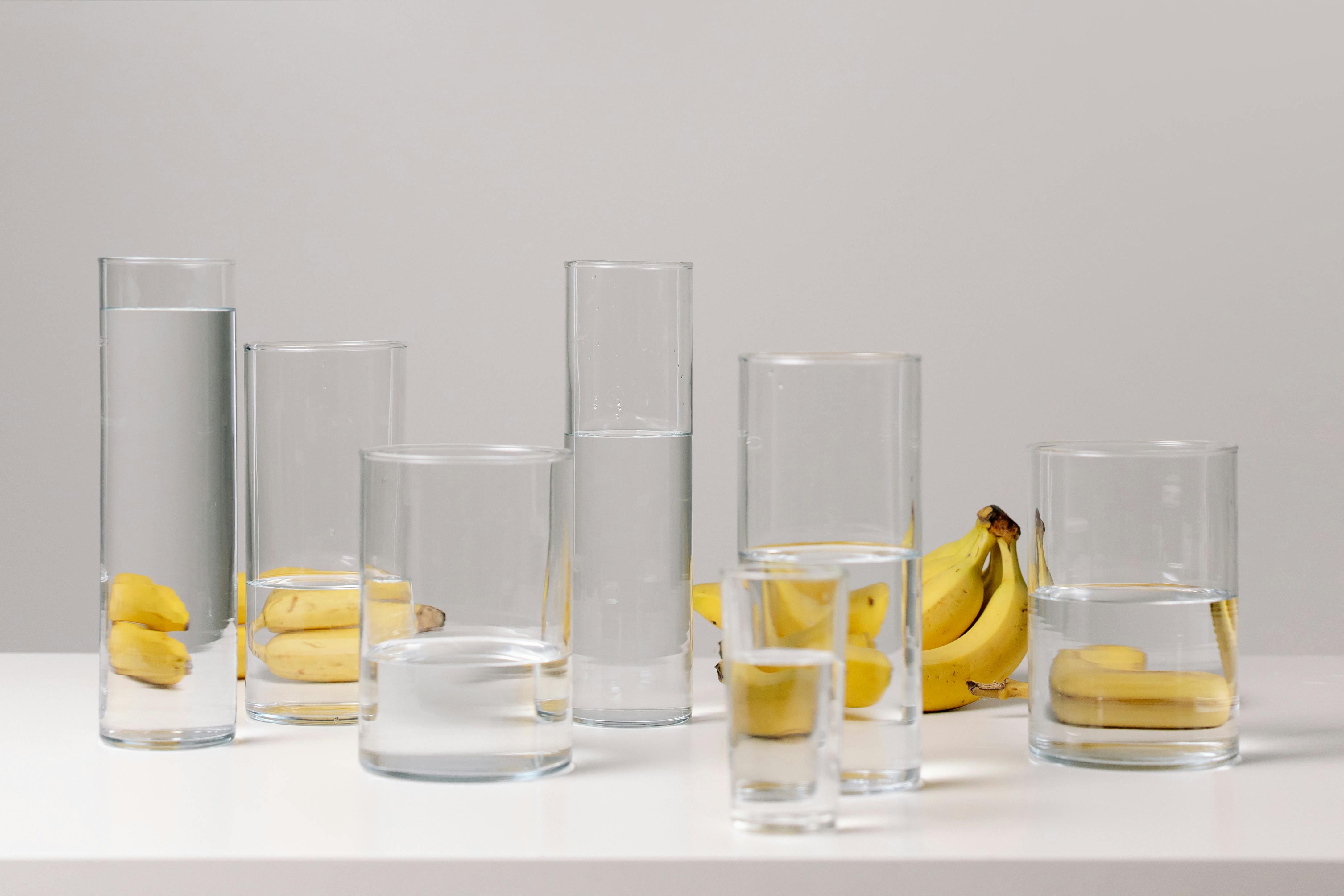
If you have a powerful prescription, you know the daily challenges are real. It’s more than just needing glasses to see; it’s a constant battle with thick, heavy, and often unflattering eyewear. But rest assured, you are far from alone in this experience. Millions of people navigate the world with a strong prescription, and understanding the shared struggles is the first step toward finding a better solution.
Understanding the Challenges of a Strong Prescription
Dealing with a high-power prescription goes beyond a simple vision correction. It impacts your comfort, your appearance, and how you perceive the world through your lenses.
The Reality of High Myopia and Hyperopia
Optometrists generally define high myopia (nearsightedness) as a prescription of -6.00 diopters or stronger. For hyperopia (farsightedness), high prescriptions present similar, if not greater, challenges in lens manufacturing.
These powerful prescriptions inevitably lead to common frustrations. Many wearers are all too familiar with the dreaded ‘coke bottle’ effect, noticeable visual distortion, and eyewear that feels incredibly heavy.
One wearer with a -9.5 prescription perfectly described the experience. She said her old glasses created a “thick, fish-bowl ring” around her field of vision. She felt it made her eyes appear “small, beady, and distorted” to others—a common cosmetic concern for those with strong minus lenses.
Common Problems with Strong Prescription Glasses
The issues with glasses for a strong prescription are universal. Do any of these sound familiar to you?
The Everyday Issues Every High-Prescription Wearer Knows
-
Weight and Comfort: This is perhaps the most immediate problem. Thick, dense lenses are heavy. This weight causes glasses to constantly slip down your nose, requiring you to push them up countless times a day. It also creates uncomfortable pressure points on your nose bridge and behind your ears, sometimes leading to headaches.
-
Visual Distortion: With standard lenses, the edges of your vision can become blurry, warped, or swimmy. This peripheral distortion can be disorienting, especially when you move your eyes instead of your whole head. It can make walking down stairs or driving feel less secure. These clarity issues don’t just stop with regular glasses; they are also a key reason people invest in high-quality sunglasses with prescription to ensure visual consistency and protection in bright light.
-
The “Coke Bottle” Effect: Cosmetically, this is a major pain point. The thick, visible edges of the lenses magnify or minify the side of your face and are a dead giveaway of a strong prescription. This can make wearers feel self-conscious about their appearance.
-
Limited Frame Options: Your choices for stylish frames become drastically limited. Not all frames, especially thin metal or large trendy styles, can support the thickness and weight of high-power lenses. You are often forced to choose smaller, sturdier, and sometimes less fashionable frames simply for functional reasons.
These combined challenges can be frustrating, but advancements in optical technology mean you no longer have to settle. Modern solutions directly address these problems. To see how the right materials and frame designs can eliminate issues like lens thickness and weight, you should browse a collection of modern eyeglasses for high prescription.
Decoding Lenses: Your Guide to Seeing Clearly and Looking Great
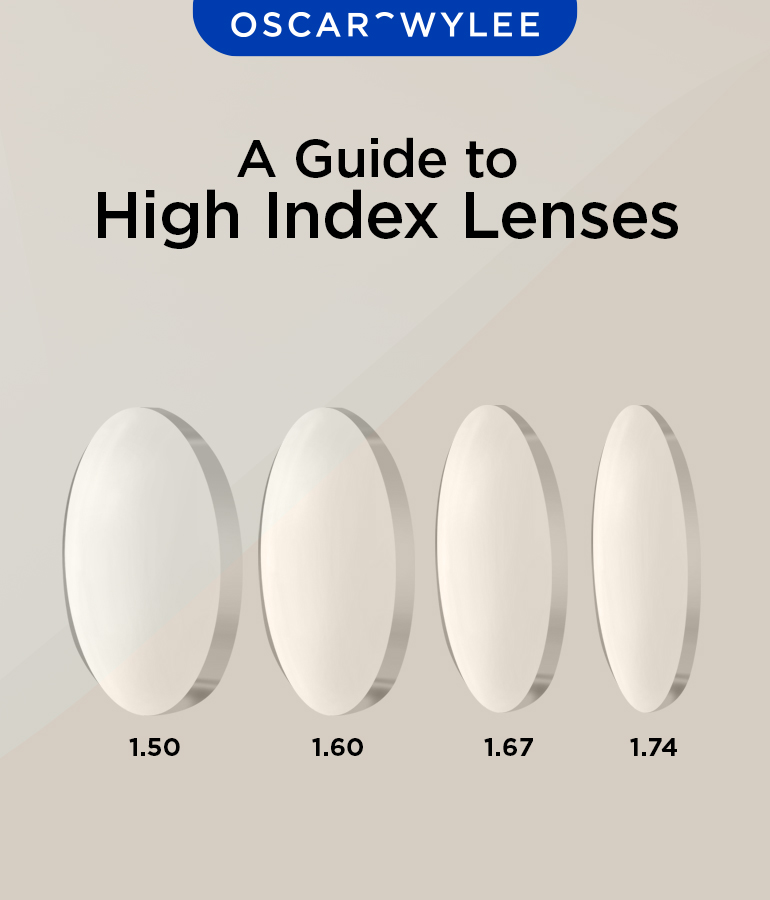
Understanding the technology behind your lenses is the key to unlocking a world of thinner, lighter, and more comfortable glasses. It’s time to move past the limitations of traditional eyewear and learn how modern optical advancements can transform your experience with a strong prescription. Let’s break down your prescription and the lens options that will make a real difference.
How to Read Your Prescription
Your prescription might look like a secret code, but it’s actually a straightforward map to your visual needs. Knowing what the numbers mean empowers you to make informed decisions about your eyeglasses.
Understanding the numbers: Sphere (SPH), Cylinder (CYL), and Axis
-
Sphere (SPH): This number indicates the main strength of your lens, measured in diopters. If the number has a minus sign (-), you are nearsighted. If it has a plus sign (+), you are farsighted. The further the number is from zero, the stronger your prescription.
-
Cylinder (CYL) & Axis: These two values work together to correct astigmatism, which is a common imperfection in the curvature of your cornea that causes blurry or distorted vision. The CYL is the power needed to correct it, and the Axis is the orientation of that correction. These are critical factors when an optometrist determines the best lens material for astigmatism.
-
Pupillary Distance (PD): This is simply the distance between the centers of your pupils. This measurement is crucial because it ensures the optical center of your lenses aligns perfectly with your eyes, providing the clearest and most effective vision.
High-Index Lenses: The Key to Thinner Glasses for a Strong Prescription
If you’ve been told your only option is thick, heavy lenses, high-index materials are the solution you’ve been waiting for.
What are high-index lenses and are they worth the cost?
These advanced lenses are made from a special plastic that bends light more efficiently than standard materials. A standard plastic lens has a refractive index of 1.50. High-index lenses, however, have a higher refractive index, meaning less material is needed to achieve the same corrective power.
-
1.67 High-Index: An excellent choice for those with prescriptions stronger than +/- 3.00 but generally less than +/- 5.00. It offers a significant reduction in thickness and weight compared to standard lenses.
-
1.74 High-Index Lenses for Strong Prescription: This is the thinnest and lightest plastic lens widely available today. It is the gold standard for anyone with a very strong prescription, such as -8.00, -10.00, or even higher. It dramatically minimizes the “coke bottle” effect, creating a sleeker and more attractive profile.
For a strong prescription, the investment in high-index lenses is absolutely worth it for the vast improvement in comfort and aesthetics.
Aspheric Lenses vs. High-Index Lenses
To tackle visual distortion, lens designers created another innovation: the aspheric lens. When combined with high-index materials, it creates the ultimate solution for high-prescription wearers.
A powerful combination for managing distortion
Traditional lenses have a simple, spherical curve, like a slice of a ball. This design can cause visual distortion, especially at the edges, and create an unflattering “bug-eye” or “tiny-eye” look.
Aspheric lenses have a more complex, flatter curvature. This advanced design reduces that peripheral distortion and ensures your eyes appear more natural in size behind the lens. This pursuit of edge-to-edge clarity is also why investing in quality sunglasses with prescription is so important, as visual integrity should never be compromised, regardless of lighting conditions.
The best part? You don’t have to choose between them. Today, most high-index lenses are automatically made with an aspheric design. This powerful combination gives you the best of both worlds: the thinnest, lightest lens possible with the widest field of clear, undistorted vision.
Understanding these lens technologies is the first step, but seeing how they work with the right frames is what truly makes the difference. To explore frames specifically designed to maximize the benefits of these advanced lenses, and to find a pair that finally solves the problem of heavy, thick eyewear, browse this curated collection of glasses for high power.
Frame Selection: The Secret to Minimizing Lens Thickness
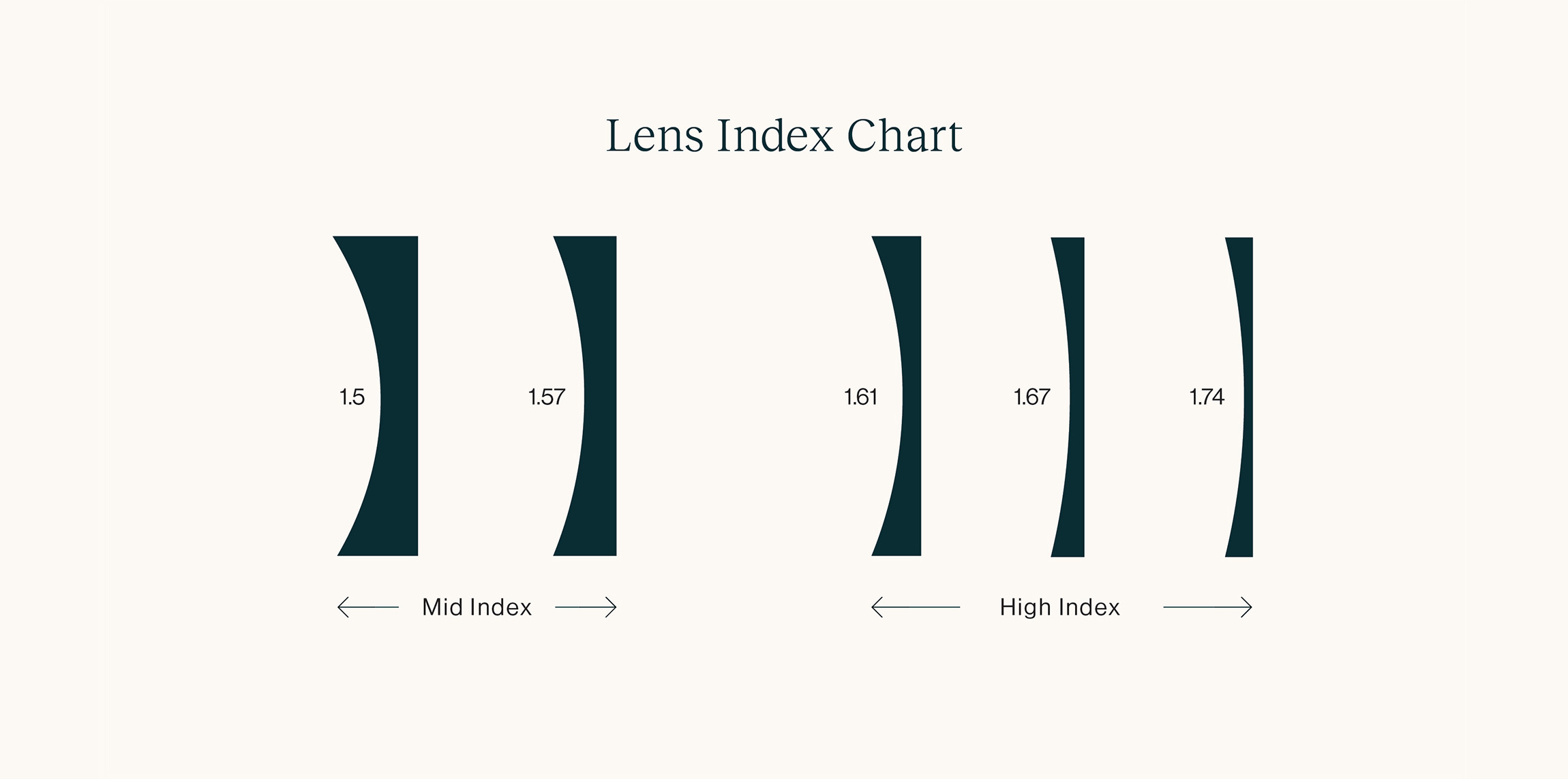
You can have the most advanced high-index lenses in the world, but if they’re placed in the wrong frame, you’ll lose many of their benefits. Choosing a frame is not just about fashion; for those with a strong prescription, it’s a strategic decision that directly impacts how thick your lenses will appear and how comfortable your glasses will feel.
The Best Frame Styles for Thick Lenses
So, how do you choose frames that effectively hide your prescription and work in your favor? The key is to select a style that conceals the inherent thickness of high-power lenses, particularly at the edges.
-
Go Smaller and Rounder: This is the most effective trick in the book. Smaller, and to some extent, rounder or oval-shaped lens areas require significantly less lens material to be cut. This directly reduces the final thickness and overall weight of your eyeglasses for high prescription.
-
Choose Thicker Frame Materials: Materials like acetate or other robust plastics are your best friends. A thicker frame provides more material to hide the edge thickness of a high-power lens, essentially tucking it out of sight. The lens edge sits neatly inside the frame, creating a much sleeker profile.
-
Avoid Rimless or Large Frames: These styles are the least forgiving for a strong prescription. Rimless and semi-rimless frames expose the thickest parts of the lens for everyone to see. Similarly, trendy oversized frames require a massive lens blank, which can make even a 1.74 high-index lens look incredibly thick, sometimes close to half an inch, at the edges.
-
Mind Your High Prescription Glasses Face Shape: While guides often suggest frames based on face shape, for a high-prescription wearer, technical suitability must come first. The priority is finding a frame that minimizes lens thickness. Once you have a selection of technically suitable frames, you can then choose the one that best complements your face shape.
Why Pupillary Distance (PD) is Non-Negotiable
Beyond the frame’s style, there is one measurement that makes or breaks the effectiveness of your glasses: your Pupillary Distance (PD). This measurement ensures the optical center of the lens aligns perfectly with your pupil.
-
An inaccurate PD, even by just a couple of millimeters, can induce eye strain, headaches, and distorted vision. For high-prescription glasses, and especially for complex progressive lenses, a precise PD is absolutely critical—an error can render them completely unusable.
-
While optometrists are required by U.S. law to give you a copy of your lens prescription, they are not always required to include your PD. You must ask for it specifically. Ensure you get both your distance and near PD if you are considering progressive or bifocal lenses.
-
Many online retailers provide tools to help you measure your PD at home. While these can be a good starting point for lower prescriptions, for a complex or strong prescription, relying on a measurement taken by a professional optician is by far the safest and most reliable option for 2025.
Mastering these measurements is a fundamental part of the journey, especially when you decide to explore the convenience and variety of buying prescription eyeglasses online.
By combining the right frame style with perfectly centered lenses, you create the ultimate solution for both clear vision and aesthetic appeal. It’s the formula for finding glasses you will truly love to wear. To see these principles in action, you can browse a collection of frames handpicked for their suitability with strong prescriptions. Finding the right pair means you no longer have to compromise on style for the sake of clear vision. Discover the best frames for high prescription that will effectively minimize lens thickness and deliver a comfortable, confident result.
Where to Buy: Online vs. In-Store for a Complex Prescription
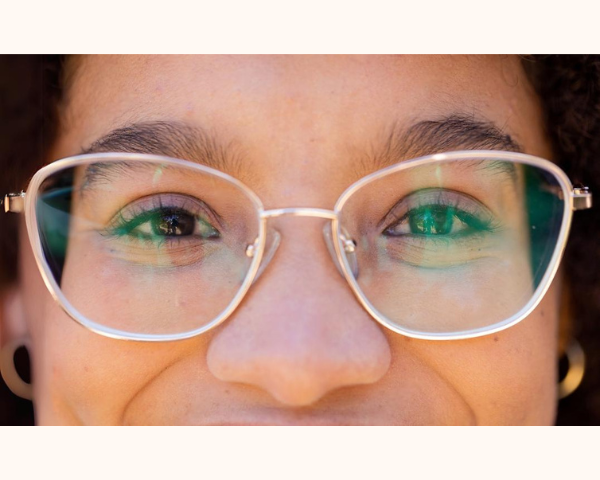
The digital age presents a major choice for anyone needing new glasses: should you visit your trusted local optician or take advantage of the vast world of online retailers? For someone with a high or complex prescription, this isn’t just a matter of preference—it’s a crucial decision that impacts cost, accuracy, and your daily comfort.
The Case for Your Local In-Store Optician
For many with significant vision correction needs, the traditional brick-and-mortar optician remains the gold standard, and for good reason. The value lies in hands-on, professional expertise.
-
Personalized Adjustments: This is arguably the biggest advantage. An experienced optician can physically adjust the frame to fit the unique contours of your face. This is vital when fitting
lightweight frames for heavy lensesto ensure they don’t constantly slide down your nose. These micro-adjustments are the difference between glasses you tolerate and glasses you love. -
Expert Guidance: An optician provides invaluable, in-person advice. They can look at your high-power prescription and immediately guide you toward frames that will work best, and away from those that will cause problems. Their expertise is especially crucial for getting
progressive lenses for high myopiafitted correctly, as the measurements must be flawless for the lenses to function properly. -
Accountability: What if something goes wrong? If your vision feels “off” in your new
strong prescription glasses, you can walk back into the store and have a professional troubleshoot the issue. This direct accountability provides a safety net that is essential when investing in high-stakes eyewear.
The Benefits and Risks of Buying Online
The allure of buying glasses online is undeniable, primarily driven by two key factors: cost and selection. But these benefits come with significant risks for the high-prescription wearer.
-
Affordability and Selection: Online retailers like Zenni, YesGlasses, and Glasses Direct can offer
eyeglasses for high prescriptionat a fraction of the cost of in-store options. Their digital storefronts also boast a seemingly endless inventory of styles, colors, and brands. -
The Catch: The trade-off for cost and variety is quality control and the absence of a professional fitting. While frame quality can be a gamble, the real danger lies in the fitting process. For a
complex prescription, submitting your own measurements can be risky. A tiny error in your Pupillary Distance (PD) or optical center height—something an optician would catch—can lead to eye strain, headaches, or glasses that are simply unwearable. This risk is even greater if you need specialized eyewear for specific activities; for example, guessing the fit for high-performance sports glasses online is rarely a recipe for success.
Ultimately, the best approach for 2025 might be a hybrid one: leverage the expertise of an in-person consultation to get precise measurements and an understanding of what frame styles work for you. Then, you can explore online retailers with more confidence. To help bridge this gap, browsing a collection of frames specifically chosen for their compatibility with strong prescriptions is an excellent starting point. It allows you to see the styles and possibilities without the guesswork.
Exploring a curated selection can help you find a pair that meets both your technical needs and your personal style. By seeing what’s available, you can make a truly informed decision. Find your perfect pair by viewing a collection of high prescription glasses frames designed to provide clear vision without compromise.
The High Prescription Problem: Why It’s So Tough
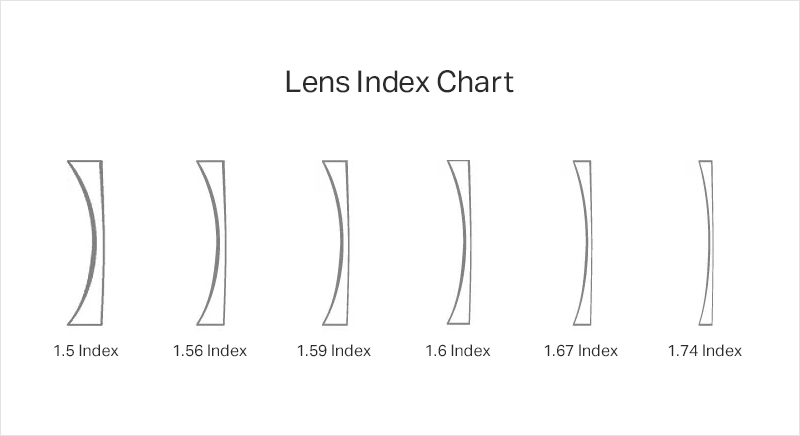
If you have a high prescription, you know the search for new glasses is more than a fashion choice—it’s a technical challenge. The numbers on your prescription dictate everything from lens thickness to frame compatibility, and frankly, it can be frustrating. Let’s demystify the complexities so you can approach buying your next pair of eyeglasses for high prescription with confidence.
Understanding Your Complex Prescription: Beyond the Basics
Ever felt like your eyeglass prescription is written in a secret code? You’re not alone. Each number is a critical instruction for the lab crafting your lenses. Understanding them is the first step toward getting glasses that you’ll love to wear.
Deciphering the Numbers
Let’s break down that script from your optometrist.
-
Sphere (SPH): This number indicates the main strength of your lens. A minus sign (-) means you have myopia (nearsightedness), making it hard to see distant objects clearly. A plus sign (+) indicates hyperopia (farsightedness), where near objects are blurry. The higher the number (e.g., -6.00, +4.50), the stronger your prescription.
-
Cylinder (CYL) & Axis: If you see numbers in these columns, you have astigmatism. This is a common condition where the cornea is shaped more like a football than a sphere, causing light to focus unevenly. The CYL number measures the degree of astigmatism, while the Axis (a number from 1 to 180) tells the lab the orientation of the correction. These are crucial for sharp, stable vision.
-
ADD (Addition): This value is for those who need bifocal or progressive lenses. It represents the “added” magnifying power in the lower part of the lens to help with reading and other close-up tasks. Getting this right is key to seamless vision at all distances.
-
Prism: A less common but vital correction, prism is used to correct for eye alignment issues. If your eyes struggle to work together, it can cause double vision or eye strain. Prism lenses bend light in a way that helps your eyes perceive a single, clear image.
Avoiding the “Coke Bottle Glasses Effect”
The most dreaded outcome for anyone with a strong prescription is the “Coke bottle” look. It’s not just about aesthetics; it’s about visual comfort and how you see the world. Fortunately, modern lens technology offers powerful solutions.
The Science Behind Thick Lenses
So, why do high-power prescriptions lead to thick lenses? It’s all about physics.
Lenses work by bending light to focus it correctly on your retina. For a high negative prescription (like -6.00, -8.00, or higher), the lens must be very thin in the center and thicker at the edges to diverge light properly. This results in those noticeably thick, heavy edges. Conversely, high positive prescriptions are thickest in the center.
This thickness leads to visual distortions. High minus lenses can make your eyes look smaller to others (minification) and shrink your field of view. These visual artifacts can be disorienting and are a significant challenge. While the primary goal is clarity, other lens features can also enhance your experience. For instance, specific tints like green sunglass lenses are engineered to boost contrast and cut down on glare, providing extra comfort for sensitive eyes, especially outdoors.
Understanding these technical hurdles is the first step. The second, more empowering step is discovering the modern frames and lenses specifically designed to overcome them. By choosing the right materials and frame shapes, you can achieve clear vision without the bulk. To see how innovative designs can solve these exact problems, explore a curated selection of eyeglasses for high prescription.
Your Ultimate Solution: High-Index Lenses
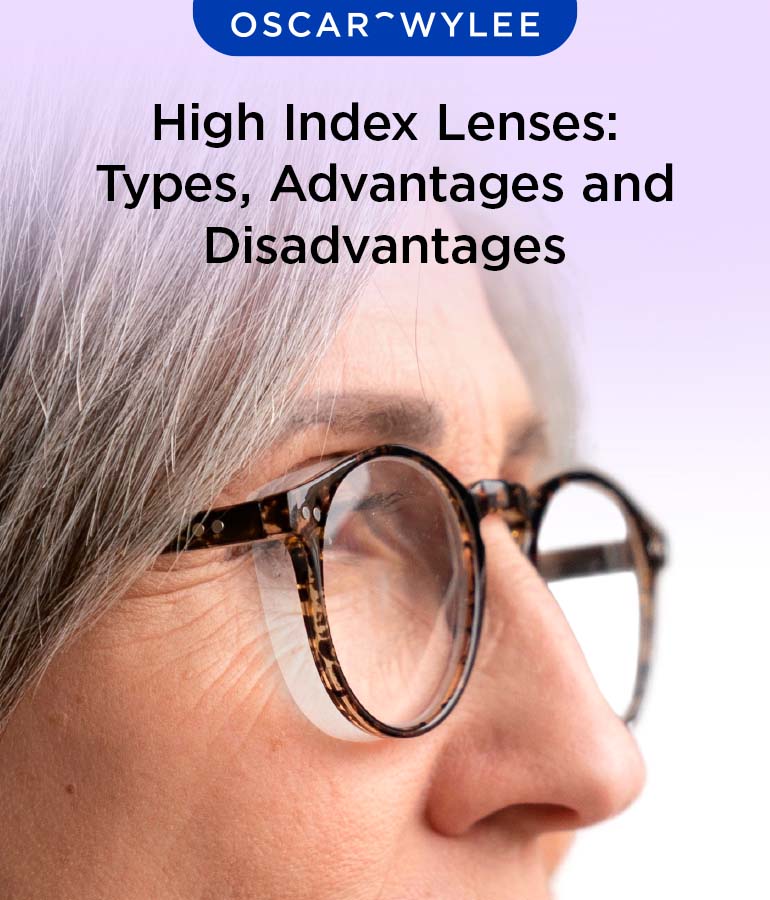
If you’ve been searching for a way to ditch thick, heavy lenses, the answer lies in a remarkable material: high-index plastic. This technology is the single most important factor in creating modern, comfortable, and attractive eyeglasses for high prescription. It directly tackles the weight and thickness that plagues standard lenses.
What Are High-Index Lenses, Really?
In simple terms, “index” refers to the refractive index of a lens material—its ability to bend light. A higher index means the material bends light more efficiently.
Because high-index materials are so efficient, they require less material and less curvature to correct the same degree of refractive error. The result? A lens that is significantly thinner and lighter than one made from a standard material. This is the key to achieving a sleek profile for a strong prescription.
A Breakdown of Lens Materials
Choosing the right material is a critical decision. Each has its own profile of thickness, weight, and durability. The same advanced material science that has improved regular glasses has also transformed prescription sunglasses, allowing for complex corrections in a variety of styles.
-
Standard Plastic (CR-39, Index 1.50): This is the baseline, the original optical plastic. It offers excellent optical clarity but becomes noticeably thick and heavy as prescription strength increases. It’s best suited for low-power prescriptions.
-
Polycarbonate (Index 1.59): The standout feature of polycarbonate is its exceptional impact resistance, making it the standard for children’s eyewear and safety glasses. It’s also thinner and lighter than CR-39, offering a moderate improvement for stronger prescriptions.
-
High-Index Plastic (1.61, 1.67, 1.74): This category is the premium solution for
lightweight eyeglasses for strong prescription. These advanced plastics are designed specifically to reduce lens volume. As you move up from 1.61 to 1.67 and finally to 1.74, the lenses become progressively thinner and lighter, offering the best possible cosmetic appearance.
Are High Index Lenses Worth the Cost?
It’s true, high-index lenses come with a higher price tag. So, is the investment justified? For anyone with a prescription above +/- 4.00, the answer is a resounding yes.
The benefits go far beyond aesthetics. Lighter lenses reduce the pressure on your nose and ears, preventing slippage and increasing all-day comfort. Thinner lenses are also compatible with a much wider array of frame styles, including semi-rimless and minimalist designs that are often unsuitable for thick, standard lenses.
High-Index 1.67 vs 1.74 Lenses Review
For those with a very strong prescription, the choice often comes down to 1.67 or 1.74 high-index plastic. A 1.67 index lens offers a fantastic balance of thinness, lightness, and cost. It provides a dramatic improvement over standard lenses.
The 1.74 index is the pinnacle of current lens technology, offering the absolute thinnest and lightest plastic lens possible. It is the top-tier choice for those with the highest prescriptions who want the sleekest look and maximum comfort.
Data Table: Comparing Lens Indices
| Lens Index | Material | % Thinner Than 1.50 | Recommended Prescription Range | Avg. Cost Increase |
|---|---|---|---|---|
| 1.50 | CR-39 Plastic | 0% | +/- 2.00 | Base Price |
| 1.61 | High-Index | Up to 25% | +/- 2.00 to +/- 4.00 | $$ |
| 1.67 | High-Index | Up to 35% | +/- 4.00 to +/- 8.00 | $$$ |
| 1.74 | High-Index | Up to 45% | Above +/- 8.00 | $$$$ |
Aspheric vs High Index Lenses: Clearing the Confusion
You may have also heard the term “aspheric” and wondered if you need to choose between it and high-index lenses. This is a common point of confusion, but the answer is simple.
It’s Not an Either/Or Choice
These two features are not in competition; they are partners that work together to create the best possible lenses.
- High-Index refers to the material the lens is made from, which is what makes it thin and light.
- Aspheric refers to the design of the lens surface. Instead of a simple, spherical curve (like a slice of a ball), aspheric lenses have a more complex, flatter curvature. This design reduces the “bug-eye” or “tiny-eye” distortion that can happen with strong prescriptions and also minimizes the “fishbowl” effect at the periphery of your vision.
The amazing part is the synergy: virtually all modern high-index lenses are made with an aspheric design. You get the thin, lightweight benefit from the material and the superior optical performance and flatter profile from the aspheric shape. This combination is what truly solves the challenges of eyeglasses for high prescription.
To truly appreciate how these advanced lens technologies can transform your eyewear experience, it helps to see them in practice. By seeing how different high-index options are paired with suitable frames, you can find the perfect balance of function and style. Explore a curated selection of powerful prescription glasses to find a pair that meets your exact needs.
The Frame Selection Guide: Making Thick Glasses Look Thinner

Now that you’ve selected the perfect high-index lenses, the next step is just as crucial: choosing the right frame. A frame is more than a holder for your lenses; it’s a strategic tool. The right choice can dramatically minimize the visible thickness of your lenses, enhance comfort, and boost your confidence in your eyeglasses for high prescription.
How to Choose Frames for Thick Lenses
Think of your frame and lenses as a team. For those with a strong prescription, making them work together harmoniously is the secret to a great-looking pair of glasses. It starts with understanding a few key principles of frame selection.
Do Smaller Frames Reduce Lens Thickness?
Yes, absolutely. The science behind this is simple. Lenses for nearsightedness (myopia) are concave, meaning they are thinnest in the center and thickest at their outer edges. When you opt for a smaller frame, the lab uses the central, slimmer part of the large lens blank they start with.
A wider or larger frame requires more of the lens blank’s surface area, inevitably cutting into the thicker peripheral zones. Therefore, choosing a smaller, more compact frame directly leads to thinner finished lens edges. Rounder shapes also help by distributing the edge thickness more evenly than angular frames.
The Best Frame Material for High Prescription
The material of your frames plays a massive role in both hiding thick lenses and ensuring all-day comfort. Balancing material choice with your budget is key to finding truly affordable prescription lenses without compromising on the features you need. Here’s how the best materials stack up:
- Acetate: These sturdy plastic frames are a fantastic choice for concealing lens thickness. The material’s natural bulk provides a substantial rim that effectively hides the lens edge, making it appear significantly thinner.
- Titanium: If your primary goal is comfort, titanium is an unparalleled option. It is incredibly strong yet feather-light. Pairing a lightweight titanium frame with high-index lenses results in
lightweight eyeglasses for strong prescriptionthat you might even forget you’re wearing. - Metal: Standard metal frames can work well, but you must be selective. Avoid the trendy, ultra-thin wire frames at all costs. They offer zero coverage and put the entire lens edge on full display, defeating all the hard work your high-index lenses are doing.
Finding Stylish Frames for Strong Myopia
Having strong myopia doesn’t mean you’re relegated to boring or unflattering glasses. In 2025, the options are better than ever. The secret is to choose frame shapes that work with your lenses, not against them, to create a stylish and sophisticated look.
Frame Shapes That Work Wonders
Certain shapes are naturally superior for accommodating stronger prescriptions.
Round and oval frames are the undisputed champions. Their continuously curved shape means there are no sharp corners where lens thickness becomes exaggerated, a common issue with angular designs. They provide the most cosmetically pleasing result for high-power lenses.
On the other hand, you should generally avoid wide, rectangular styles. The long horizontal lines and sharp corners of these frames inevitably draw attention to the thickest part of your lenses. For the same reason, rimless and semi-rimless frames are typically not recommended, as they leave the lens edge entirely exposed.
Case Study: Think of a customer who, for years, wore wide, square frames and was always conscious of his “coke-bottle” look. After a consultation, he switched to a pair of classic round acetate frames. The change was staggering. The lenses instantly appeared thinner, and the new shape provided a more balanced and flattering look for his face. It was a complete confidence transformation.
Understanding these principles of frame shape and material is the key to unlocking a better eyewear experience. The best way to see how they come together is to view a curated collection of frames ideal for stronger prescriptions. Exploring options firsthand allows you to find a pair that perfectly matches your vision needs and personal style. Discover your perfect pair by browsing a selection of frames for thick glasses designed to make you look and feel your best.
Review: Best Online Eyewear Retailers for High Prescriptions

Navigating the world of online eyewear can be a challenge, especially when searching for the perfect eyeglasses for high prescription. The stakes are higher; you need precision, quality materials, and a frame that complements your powerful lenses. In our comprehensive 2025 review, we analyze the top online retailers to determine who truly delivers for shoppers with strong prescriptions.
The Budget Champion: Zenni for Strong Prescriptions
Zenni Optical has built a reputation as the undisputed king of affordable eyewear. If your primary concern is price, it is nearly impossible to beat. But can they handle the complexities of a high prescription? For the most part, yes, but it requires you to be an informed consumer.
What We Like
- Price: It’s the main draw. With basic frames starting around $7 and very reasonably priced high-index lens packages, Zenni is the most accessible entry point for anyone needing
eyeglasses for high prescription. - Selection: The sheer volume is staggering. With over 3,000 frames, you have a massive pool of styles, colors, and materials to choose from.
What to Be Cautious About
- The Process: The do-it-yourself model can be overwhelming. You must have an accurate, up-to-date prescription and a precise Pupillary Distance (PD) measurement. Any small error can be problematic for high powers.
- Progressive Lenses: This is a crucial point for some. Zenni uses free-form progressive lenses. While functional, they typically have a narrower corridor of clear vision compared to premium, branded lenses. Users with complex prescriptions or those sensitive to visual distortions may find the adjustment period difficult.
The Boutique Experience: Warby Parker High Index Options
Warby Parker offers a completely different approach. They focus on a curated, fashion-forward experience with a simplified process that feels more like visiting a modern boutique than a massive online warehouse.
What We Like
- Home Try-On: This is a game-changer. You can select five frames to try at home for free. This allows you to see how frames actually look and feel, which is essential when trying to find a style that minimizes the appearance of
thick lenses. - Style and Service: Warby Parker’s in-house designs are consistently stylish and on-trend. Their customer experience is smooth, from the website interface to their helpful support, making the process feel less intimidating.
- High-Index Availability: They cater directly to users with stronger needs by offering 1.67
high-indexlenses, a must-have for achieving a thinner and lighter result withstrong prescriptions.
What to Be Cautious About
- Price: A complete pair of single-vision glasses starts at $95. While this includes the frame and basic lenses, it’s a significant price jump from Zenni.
- Brand Limitations: You can only buy Warby Parker frames. If you have your heart set on a specific designer brand, you’ll have to look elsewhere.
The Quality Contender: EyeBuyDirect vs Zenni for High Prescription
So, where does EyeBuyDirect fit in? Think of it as the middle ground that balances cost, quality, and customization, making it a strong contender for those seeking more than what budget retailers offer.
What We Like
- Perceived Quality: Many users report that EyeBuyDirect’s frames and lenses feel a step up in quality and durability compared to the most basic options online. While they have budget-friendly styles, they also offer premium collections that provide the aesthetic and build quality you might find in some men’s designer glasses frames.
- Lens Customization: This is a key advantage for
strong myopia. EyeBuyDirect provides multiple tiers ofhigh-indexlenses (often 1.67 and 1.74) and a variety of advanced coatings, allowing you to build a truly customized pair of glasses for your specific visual needs.
What to Be Cautious About
- Cost: While generally more affordable than Warby Parker, it is pricier than Zenni. However, EyeBuyDirect frequently runs sales and promotions that can bring the cost down significantly.
- Return Policy: Their 14-day return and one-time replacement exchange window is functional but shorter than some competitors, requiring you to make a decision more quickly.
Each retailer offers distinct advantages depending on your priorities—be it budget, style, or fine-tuned customization. The best way to determine the right fit for your needs is to directly compare frames, lens options, and final costs. Exploring a curated selection can help you confidently find the ideal eyeglasses for high prescription that make you look and feel great.
The Ultimate Guide to Ordering Complex Prescriptions Online
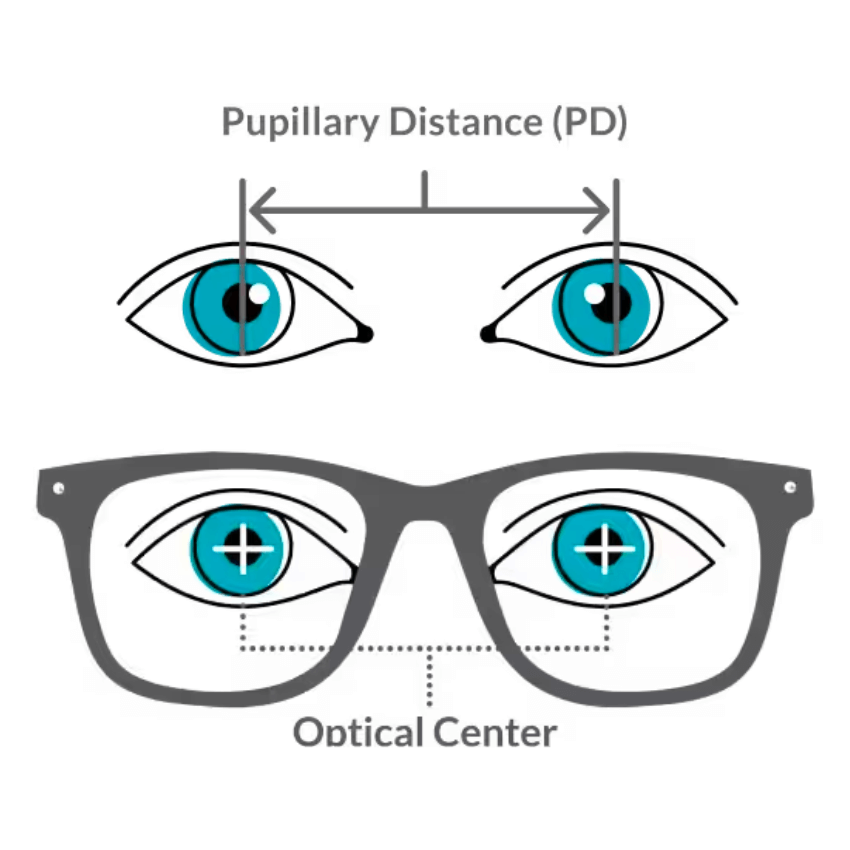
Ordering eyeglasses for high prescription online can feel like a high-wire act. You’re not just picking a style; you’re entrusting a remote vendor with your most critical sense. But with the right preparation and knowledge, you can navigate the process with confidence. This guide breaks down the essential steps for a successful 2025 online purchase.
Step 1: Getting Your Prescription Right
This is the foundation of your entire purchase. An error here will render even the most expensive frames and lenses useless. It is the single most important document in this process, especially when dealing with a high prescription.
Essential Information Needed
Your prescription is more than just a series of numbers; it’s the blueprint for your vision. Before you even start browsing, ensure you have:
- A valid, up-to-date prescription from your optometrist. In most regions, this means it should be less than two years old (or one year, depending on local regulations). Your vision can change, and using an old prescription is a recipe for failure.
- Your Pupillary Distance (PD). Critically, you must insist that your eye doctor includes your PD on the prescription slip. This measurement is vital for properly aligning the optical center of the lenses, a detail that becomes more crucial as your prescription strength increases.
Step 2: Measuring Pupillary Distance for a Strong Prescription
Let’s talk more about Pupillary Distance, or PD. For a standard, low-power prescription, a millimeter of error might go unnoticed. For a strong prescription, that same millimeter can be the difference between clear vision and a headache.
Why PD is Non-Negotiable
The optical center of each lens must be perfectly aligned with the center of your pupil. If the PD is incorrect on eyeglasses for high prescription, the light will not pass through the ideal point in the lens. This can lead to prismatic effects, causing symptoms like eye strain, headaches, blurred vision, and a feeling of being “off-balance.” It’s not a detail you can afford to estimate.
How to Measure It
You have a few reliable options for obtaining this crucial number:
- Ask Your Optometrist: This is the gold standard. Request your PD measurement during your eye exam. They have the precise tools to measure it perfectly.
- Use an Online Retailer’s Tool: Many reputable online sellers (like Warby Parker or Bailey Nelson) have developed sophisticated digital tools, often within their apps, that use your phone’s camera to measure your PD accurately.
- The “Credit Card Selfie” Method: Some sites guide you to take a photo of yourself holding a standard-sized magnetic stripe card (like a credit card or library card) below your nose. The site’s software uses the card for scale to calculate your PD. Use this as a last resort, as its accuracy can vary.
Step 3: Navigating Lens Options and Coatings
With a precise prescription in hand, the next step is choosing the right lens features. For eyeglasses for high prescription, lens coatings aren’t frivolous up-sells; they are essential components for visual comfort and lens durability. The right coatings are just as important for complex distance glasses as they are for high-quality fashionable reading glasses womens.
Must-Have Coatings
When building your lenses online, consider these three coatings non-negotiable:
- Anti-Reflective (AR): This is arguably the most important coating. It dramatically reduces glare from light sources (like headlights at night or overhead office lights) and eliminates distracting reflections on the surface of your lenses. A huge bonus for high prescriptions is that it makes the thick lenses appear more invisible, allowing people to see your eyes more clearly.
- Scratch-Resistant: High-index lenses are a significant investment. A scratch-resistant coating provides a hardened layer that protects your lenses from the minor drops and scuffs of daily life, ensuring their longevity.
- UV Protection: Think of this as sunscreen for your eyes. Protecting your eyes from harmful ultraviolet rays is a long-term health imperative that helps prevent conditions like cataracts and macular degeneration.
Successfully ordering your glasses online hinges on getting these details right. By ensuring you have a current, complete prescription and selecting the essential coatings, you empower yourself to make a smart purchase. The best online retailers make this process straightforward by clearly presenting these choices. To see how these options can be easily configured, you can browse a diverse collection of glasses for complex prescriptions and find a pair that perfectly matches your needs.
Frequently Asked Questions (FAQ)

We get it. Venturing into the world of online shopping for eyeglasses for high prescription can bring up a lot of questions. Let’s tackle some of the most common ones we hear from shoppers in 2025.
What is the thinnest lens available for a -8 prescription?
For a prescription of -8.00, you are firmly in the high prescription category. Your primary goal is likely to minimize the “coke bottle” effect, where the edges of the lenses are noticeably thick.
Expert Recommendation
A 1.74 high-index lens is unequivocally the best choice for making thick glasses look thinner at this prescription strength. This is the thinnest and lightest plastic lens material widely available. To maximize the cosmetic benefit, you should pair these lenses with a smaller, preferably round or oval, frame. This combination ensures the thickest part of the lens is trimmed away during the cutting process.
What is the highest index lens available?
This question often comes up when people are looking for the absolute thinnest lens possible for their strong prescription. The answer depends on the material you are willing to consider.
The Technical Answer
For plastic lenses, which are the standard for safety and weight, 1.74 is the highest index commonly offered by online retailers. However, glass lenses can be made with a higher refractive index, some reaching up to 1.90. While a 1.90 index lens is technically thinner, it comes with significant drawbacks: it’s much heavier and more brittle than plastic, making it a less practical and less common choice for everyday eyeglasses for high prescription.
What are the biggest challenges of buying high prescription glasses online?
While buying glasses online offers convenience and savings, it presents unique hurdles for those with complex vision needs. Being aware of these potential pitfalls is the first step to overcoming them.
A Summary of Common Pitfalls
The main challenges are precision, fit, and advanced lens options.
- Getting Measurements Right: As we’ve stressed, an accurate Pupillary Distance (PD) is non-negotiable. Beyond that, understanding frame dimensions (like lens width and bridge width) is crucial. A frame that is too wide will result in thicker, heavier lenses.
- The Lack of In-Person Adjustments: A local optician can bend and shape the frame to sit perfectly on your face, ensuring the optical center is correctly positioned and the frames don’t slide down your nose. You lose this hands-on service when you buy online. Understanding these challenges is key, as many people successfully navigate them. Our in-depth review of popular retailers like the eye glasses zenni platform explores how different companies attempt to tackle these very issues.
- Potential Lens Technology Limits: While online retailers offer excellent standard lenses, they may not have access to the latest brand-name or highly customized lens designs (like certain free-form digital progressives) that a private optometry practice might recommend for the most complex cases of
eyeglasses for high prescription.
Seeing these concepts and options in a real-world shopping environment can help demystify the entire process. To see how different frames, lens indices, and coatings come together, exploring a curated collection can be incredibly helpful. You can apply what you’ve learned by browsing a wide range of powerful prescription glasses and finding the perfect combination for your specific needs.
Your Path to Lighter, Thinner High-Prescription Glasses
Navigating the world of high-prescription eyewear no longer has to be a frustrating compromise. By arming yourself with the right knowledge, you can confidently select glasses that are not only visually sharp but also comfortable and stylish. The key takeaways from this guide provide a clear roadmap to success. First, embrace the power of high-index lenses; choosing a 1.67 or, for the strongest prescriptions, a 1.74 index is the single most effective step toward reducing lens thickness and weight. These materials are almost always paired with an aspheric design, which further enhances visual clarity and reduces the unflattering eye distortion common with powerful lenses.
Second, recognize that your frame choice is a strategic decision. Opting for smaller, rounder, or oval-shaped frames directly minimizes the final lens thickness. Complement this with a frame material like sturdy acetate or ultra-light japanese titanium glasses to either conceal the lens edge or reduce the overall weight to a minimum. Finally, never underestimate the importance of a precise Pupillary Distance (PD) measurement. This non-negotiable detail ensures your lenses are perfectly centered, providing optimal vision without strain. Armed with these principles, you are fully equipped to find eyeglasses for high prescription that you will truly love to wear.

Leave a Reply